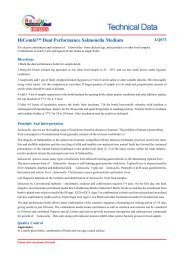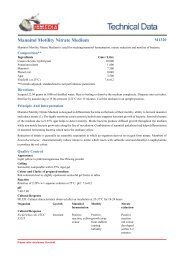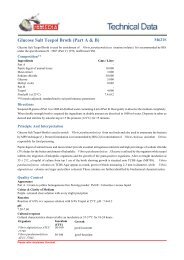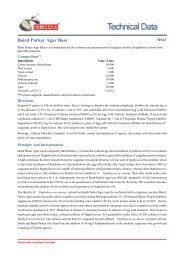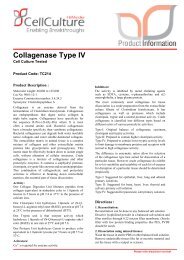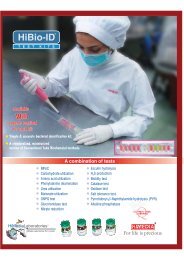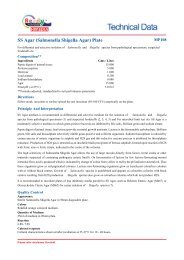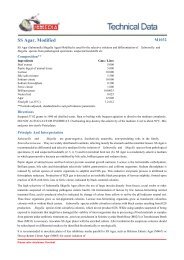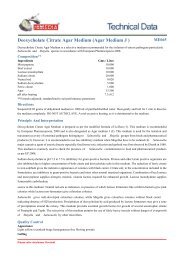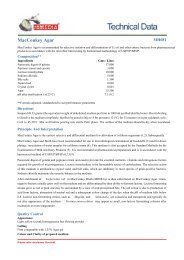M1217 - HiMedia Laboratories
M1217 - HiMedia Laboratories
M1217 - HiMedia Laboratories
You also want an ePaper? Increase the reach of your titles
YUMPU automatically turns print PDFs into web optimized ePapers that Google loves.
Tryptone Sucrose Tetrazolium Agar Base (TSTA)<br />
Tryptone Sucrose Tetrazolium Agar Base (TSTA) with addition of Triphenyl Tetrazolium Chloride is recommended for<br />
isolation of Vibrio species.<br />
Composition**<br />
Ingredients Gms / Litre<br />
Casein enzymic hydrolysate 15.000<br />
Papaic digest of soyabean meal 5.000<br />
Sodium chloride 30.000<br />
Saccharose 20.000<br />
Bile salts 0.500<br />
Agar 15.000<br />
Final pH ( at 25°C) 7.1±0.2<br />
**Formula adjusted, standardized to suit performance parameters<br />
Please refer disclaimer Overleaf.<br />
<strong>M1217</strong><br />
Directions<br />
Suspend 85.5 grams in 1000 ml distilled water. Heat to boiling to dissolve the medium completely. Sterilize by autoclaving at<br />
15 lbs pressure (121°C) for 15 minutes. Cool to 45-50°C and aseptically add 3 ml of 1% 2, 3, 5-Triphenyl Tetrazolium Chloride<br />
(TTC) (FD057). Mix well before pouring into sterile Petri plates.<br />
Principle And Interpretation<br />
The Vibrionaceae are straight or curved, gram-negative rods, motile by polar flagella. Many strains require 2-3% sodium<br />
chloride for growth and are primarily inhabitants of aquatic environments. Of the 35 Vibrio species recognized, 12 have<br />
been implicated in gastrointestinal and extra-intestinal infections in man; the most important of these is cholera. The species<br />
most frequently isolated from clinical specimens are strains of Vibrio cholerae , Vibrio parahaemolyticus , Vibrio<br />
vulnificus , Vibrio mimicus and Vibrio alginolyticus (1).<br />
Tryptone Sucrose Tetrazolium Agar is formulated in accordance with Kourany medium (2) and is approved by ISO Committee<br />
(3) for the isolation of Vibrio species, especially V. parahaemolyticus Casein enzymic hydrolysate and papaic digest<br />
of soyabean meal provide nitrogenous compounds and other essential growth nutrients. Saccharose (sucrose) is the energy<br />
source. High salt concentration makes it specific for organisms having high osmotic tolerance. Bile salts inhibit gram-positive<br />
organisms. TTC is reduced by V. parahaemolyticus to red formazan dyes, visualized as red colonies.<br />
Inoculate 25 grams of the test sample into 225ml of Salt Polymyxin Broth Base (M821I). Incubate at 35-37°C for 7 to 8<br />
hours. After incubation, inoculate a loopful onto TCBS Agar (M189) & Tryptone Sucrose Tetrazolium Agar Base (<strong>M1217</strong>).<br />
Presumptive V. parahaemolyticus colonies are further confirmed by appropriate biochemical tests.<br />
Quality Control<br />
Appearance<br />
Cream to yellow homogeneous free flowing powder<br />
Gelling<br />
Firm, comparable with 1.5% Agar gel<br />
Colour and Clarity of prepared medium<br />
Light yellow coloured clear to slightly opalescent gel forms in Petri plates.<br />
Reaction<br />
Reaction of 8.55% w/v aqueous solution at 25°C. pH : 7.1±0.2<br />
pH<br />
6.90-7.30<br />
Cultural Response<br />
<strong>M1217</strong>: Cultural characteristics observed after an incubation at 35-37°C for 24-48 hours.
<strong>HiMedia</strong> <strong>Laboratories</strong> Technical Data<br />
Organism<br />
Cultural Response<br />
Inoculum<br />
(CFU)<br />
Growth Recovery<br />
Vibrio parahaemolyticus<br />
ATCC 17802<br />
50-100 good-luxuriant >=50%<br />
Vibrio cholerae ATCC<br />
15748<br />
50-100 good-luxuriant >=50%<br />
Storage and Shelf Life<br />
Store below 30°C in tightly closed container and the prepared medium at 2 - 8°C. Use before expiry date on the label.<br />
Reference<br />
1. Collee J. G., Fraser A. G., Marmion B. P., Simmons A., (Eds.), Mackie and McCartney, Practical Medical Microbiology,<br />
1996, 14th Edition, Churchill Livingstone<br />
2. Kourany M., 1983, Appl. Environ. Microbiol., 45: 310.3. International Organization for Standardization (ISO) 1990, Draft,<br />
ISO/DIS 8914.<br />
Disclaimer :<br />
Revision : 1 / 2011<br />
User must ensure suitability of the product(s) in their application prior to use. Products conform solely to the information contained in<br />
this and other related <strong>HiMedia</strong> publications. The information contained in this publication is based on our research and development<br />
work and is to the best of our knowledge true and accurate. <strong>HiMedia</strong> <strong>Laboratories</strong> Pvt Ltd reserves the right to make changes to<br />
specifications and information related to the products at any time. Products are not intended for human or animal or therapeutic use but<br />
for laboratory,diagnostic, research or further manufacturing use only, unless otherwise specified. Statements contained herein should not<br />
be considered as a warranty of any kind, expressed or implied, and no liability is accepted for infringement of any patents.<br />
<strong>HiMedia</strong> <strong>Laboratories</strong> Pvt. Ltd. A-516,Swastik Disha Business Park,Via Vadhani Ind. Est., LBS Marg, Mumbai-400086, India. Customer care No.: 022-6147<br />
1919 Email: techhelp@himedialabs.com



